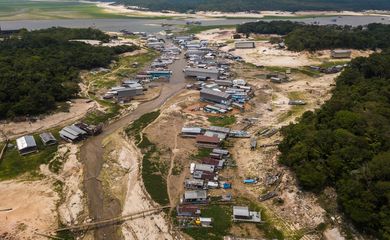Paraguay River records historic low in driest year in Pantanal

The Paraguay River has recorded its lowest level ever, according to the Brazilian Geological Survey (SGB), dropping to 62 centimeters below the reference level. The measurement series began in 1900 by the Navy at the Ladário station in Corumbá, Mato Grosso do Sul state, near the border with Porto Quijarro, Bolivia. The previous record low, set in 1964, was 61 centimeters below the reference level.

The standard level of the Paraguay River is an average depth of 5 meters, according to the Mato Grosso do Sul Environment Institute (Imasul). The institute had already alerted about the river's historical low on Wednesday (Oct. 9), based on its own measurements. The Ladário station serves as a key reference point for the Navy when assessing navigation conditions and determining necessary restrictions.
The Paraguay River originates in Mato Grosso and flows through Mato Grosso do Sul before continuing to Paraguay and Argentina. Its springs are fed by waters from the Amazon, including the Rio Negro. The region is currently facing a historic drought.
The Paraguay Hydrographic Region, as reported by the National Water and Sanitation Agency (ANA), encompasses 4.3 percent of Brazil's territory. This region spans parts of Mato Grosso and Mato Grosso do Sul, including the majority of the Pantanal in Mato Grosso, which is the largest continuous wetland area on the planet.
In a statement, Imasul explains that the decline in the Paraguay River's level has significant implications for both the economy and the environment, impacting tourism, fishing, and the livelihoods of riverside communities. “Experts attribute this drastic reduction to climate variability and insufficient rainfall in the river basin. The Pantanal, one of the planet's most fragile and vital biomes, is particularly vulnerable to these changes, which affect both biodiversity and human populations,” the note reads.
Slow recovery
According to projections from the SGB, the recovery of levels in the Paraguay River Basin is expected to be gradual. The readings at the Ladário station in Corumbá are predicted to remain below the reference level until the second half of November. “We've observed a significant slowdown in the river's rate of descent, which has stabilized since last Monday (7) following the first rains of the rainy season. While rainfall is expected to continue, it will not be heavy enough to contribute to rapid increases in this section or throughout the basin,” stated researcher Marcus Suassuna in an institutional statement.
The decade has been marked by rainy seasons that have been insufficient for the recovery of reserves. According to the SGB, during the rainy season that began in October 2023, an accumulated deficit of 395 millimeters of rain was recorded. The estimated total was 702 mm, while the expected average was 1,097 mm. Over the decade, from 2020 to 2024, the total deficit reached approximately 1,020 mm, equivalent to the average precipitation of an entire hydrological year.
Alerts
The Navy has issued a series of alerts regarding the Paraguay River, primarily indicating deteriorating navigation conditions. The region has experienced continuous boat traffic since the 18th century, establishing a vital integration corridor with neighboring countries. Currently, it is one of six waterways prioritized for concession bidding to the private sector by the National Waterway Transportation Agency (ANTAQ), alongside the Madeira, Tapajós, Tocantins, Lagoa Mirim, and Barra Norte waterways. This project aims to accelerate the transportation of cargo, particularly agricultural and mineral products, enhancing their processing and export capabilities.




